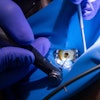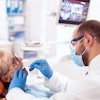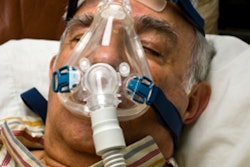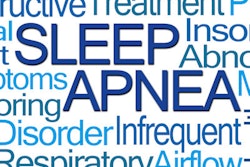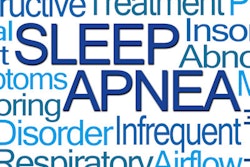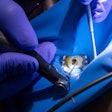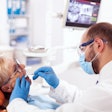
Mandibular advancement devices (MADs) have become the main alternative to continuous positive airway pressure (CPAP) devices for obstructive sleep apnea, with similar outcomes for improving sleepiness and other metrics. However, while CPAP appears to improve endothelial function in obstructive sleep apnea patients, less is known about the effects of MAD therapy on this factor.
The authors of a new study conducted a randomized controlled trial on the effects of MAD treatment on endothelial function in severe obstructive sleep apnea (OSA) patients. The results of the study, which were reported in the American Journal of Respiratory and Critical Care Medicine (January 27, 2017), were mixed.
"In moderately sleepy patients with severe OSA, MAD therapy reduced sleep-disordered breathing and OSA-related symptoms with no effect on endothelial function and blood pressure despite high treatment compliance," concluded the authors, who are based at various universities in France.
The lead author, Frédéric Gagnadoux, MD, is a professor of pulmonology at the University Hospital of Angers.
Breathing easier
The use of CPAP is first-line therapy for moderate to severe OSA. However, with 40% of patients prescribed CPAP at risk of nonadherence to using the device, MAD has become the main therapeutic alternative, the authors explained. While CPAP is more effective at reducing sleep-disordered breathing, the therapies have been found to have similar outcomes for sleepiness, neurobehavioral functioning, quality of life, and cardiac autonomic function.
“In moderately sleepy patients with severe OSA, MAD therapy reduced sleep-disordered breathing and OSA-related symptoms with no effect on endothelial function and blood pressure despite high treatment compliance.”
Studies of endothelial function in OSA patients who undergo CPAP therapy have reported conflicting results, although the authors of the current study pointed to a meta-analysis published in Respirology in 2015 that found CPAP leads to significant endothelial function improvement. However, the effects of MAD on endothelial function in these patients have not been examined in high-quality studies. Endothelial dysfunction can lead to the development of coronary heart disease and other artherosclerotic diseases.
The authors, therefore, conducted a multicenter randomized controlled trial comparing improvements in endothelial function in 150 patients with severe OSA and no overt cardiovascular disease using either MAD or a sham device. Participants were ages 18 to 70 for whom MAD was considered second-line therapy because of intolerance to CPAP.
The device was custom-made of an adjustable two-piece acrylic oral appliance (SomnoMed) with attachments of various sizes allowing for mandibular advancement adjustment. Patients were told that the aim of the study was to evaluate the effectiveness of the two devices for OSA.
The patients underwent baseline monitoring involving overnight in-lab polysomnography, peripheral arterial tonometry (PAT) to measure endothelial function, in-clinic blood pressure measurement, and 24-hour ambulatory blood pressure monitoring.
This was followed by a six-week-long MAD acclimatization period designed to optimize MAD adaptation during which the mandible was incrementally advanced by 1-mm steps every one or two weeks until achieving symptom relief or adverse effects prevented further advancement. After a one-week washout period, patients used the device to which they were assigned for two months.
After two months, a complete response, denoted by at least a 50% improvement in the apnea-hypopnea index (AHI) to less than 5, was achieved in 9.7% of individuals who used MAD. AHI measures sleep apnea severity by indicating the number of apnea and hypopnea events per hour of sleep. A partial response of a reduction by at least 50% to 5 or greater was achieved in 45.3% of patients who used MAD.
There was no difference between the treatment groups in the change in the reactive hyperemia index (RHI) measured by PAT. However, a post-hoc analysis found a significant improvement in RHI in those with low baseline RHI treated with either device but no significant intergroup difference.
| Effects of MAD vs. placebo on peripheral endothelial function assessed by RHI | ||||
| Effective MAD | Placebo device | |||
| Baseline | Follow-up | Baseline | Follow-up | |
| Overall population | 2.13 | 2.10 | 2.17 | 2.04 |
| Low RHI population | 1.65 | 1.93 (p < 0.01 vs. baseline) | 1.64 | 1.88 (p < 0.05 vs. baseline) |
After adjustment for baseline values, age, gender, body mass index, and AHI, MAD was found to be significantly better than the sham device at reducing AHI, apnea index, 3% Oxygen Desaturation Index, and the microarousal index but not at reducing scores on the Epworth Sleepiness Scale (ESS).
Use of MAD was also associated with significant improvement in snoring, fatigue, and complaints of sleepiness, as well as greater global treatment satisfaction, compared with use of the sham device. Side effects were not significantly different between the groups.
The authors provided several hypotheses for their negative RHI findings. Previous studies with higher response rates despite similar degrees of mandibular advancement included a majority of patients with mild-to-moderate OSA or excluded MAD nonresponders during the titration procedure. Also a two-month intervention may not have been long enough to detect an improvement in RHI.
Healthier population
The study's negative findings regarding blood pressure should not be generalized to all OSA patients as the participants had several baseline characteristics associated with lower blood pressure reduction in response to sleep apnea therapy, including a low prevalence of hypertension, low baseline blood pressure values, and mild daytime sleepiness, the authors wrote. They also noted that improvements in ESS were seen with both devices but that changes were not significantly different between the groups.
"Since all patients underwent a six-week MAD acclimatization period, it can be hypothesized that some participants would have detected a difference in mandibular advancement when randomized to the sham device, which may have influenced improvements of symptoms," they wrote.
The study also included a relatively small proportion of patients with obesity and metabolic disorders and no patients with overt cardiovascular disease, which allowed for focusing on the impact of OSA without confounders, the authors noted.
At the same time, the exclusion of patients with overt cardiovascular disease probably contributed to the fact that the patients had a mean baseline RHI within the normal range despite having OSA, which may have been associated with a floor effect of the intervention.
"Further studies are required to determine whether MAD therapy for OSA can improve endothelial function in patients with overt cardiovascular disease and metabolic disorders who exhibit more severe endothelial dysfunction at baseline," the authors concluded.

